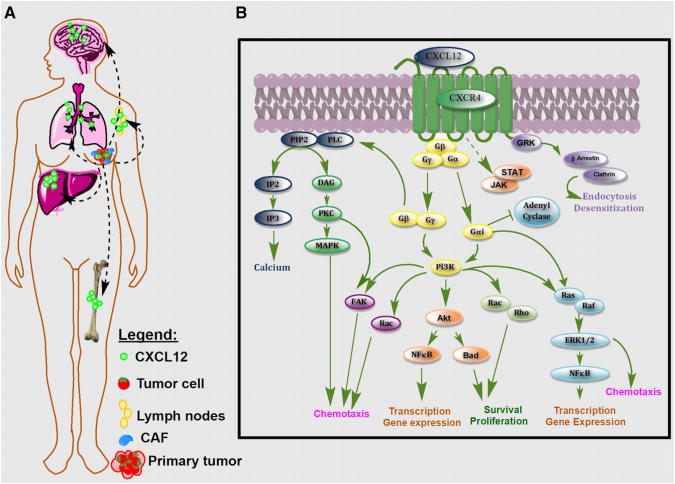Figure 1.
(A) CXCL12 is abundantly expressed in normal tissues such as lungs, liver, and bone marrow and is also secreted by tumor and stromal cells. CXCR4–CXCL12 interactions in tumor induce release of vascular endothelial growth factor, increase vascular permeability, and promote tumor angiogenesis and recruitment of tumor-associated macrophages. The resulting increased proliferative, migratory, and invasive properties of tumor cells enable their escape from primary tumors. Tumor cells that overexpress CXCR4 migrate toward the chemoattractant gradient, like leukocytes, and home to organs that release CXCL12. (B) Activation of CXCR4 by CXCL12 in primary tumor and in metastases leads to G-protein–coupled signaling through IP3, PI3K/Akt, and MAPK pathways, promoting cell survival, proliferation, and chemotaxis. Akt 5 serine/threonine protein kinase Akt (or protein kinase B, PKB); Bad 5 Bcl-2–associated death promoter; CAF 5 carcinoma-associated fibroblast; DAG 5 diacylglycerol; GRK 5 G protein–coupled receptor kinases; FAK 5 focal adhesion kinase; IP2 5 inositol (1,4)-bisphosphate; IP3 5 inositol (1,4,5) trisphosphate; PIP2 5 phosphatidylinositol 4,5-bisphosphate; Pl3K 5 phosphoinositide 3-kinase; PKC 5 protein kinase C; PLC 5 phospholipase C; Ras 5 rat sarcoma protein family; Rho 5 Rho family of GTPases.

